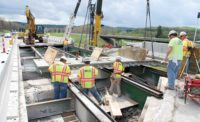In August 2007, the safety of bridges on the U.S. highway system came into the spotlight following the collapse of the Interstate 35W bridge in Minneapolis, Minnesota. As a result of that accident, Colorado took a closer look at its bridges and how to accelerate replacement of poor bridges across the state. Six years later, the Colorado Dept. of Transportation rates 95% of the state’s bridges in “good” or fair condition.
CDOT’s rapid progress on repairing and replacing the state’s deficient bridges is due to the FASTER (Funding Advancement for Surface Transportation and Economic Recovery) legislation passed in March 2009. The legislation created the Colorado Bridge Enterprise (CBE) and identified a dedicated funding source for repairing and replacing poor bridges across the state highway system.
“Since the CBE’s focus is to address the poor bridges in our state, motorists can see improvements in every part of the state, not just the urban areas,” said CDOT Executive Director Don Hunt. “By replacing these poor bridges, we are improving our highway infrastructure and creating a safer trip for motorists.”
As of July 31, the CBE has replaced 53 bridges with another 22 under construction and 33 in design. Some of major bridge projects in northeastern Colorado that are under way or recently completed include:
• I-25 Frontage Road Over Little Thompson River: The $1.3-million bridge replacement project replaced the original steel arch bridge on the I-25 frontage road between Mead and Johnstown. Crews demolished and replaced the original bridge with a longer and higher concrete structure to accommodate the flood flow of the Little Thompson River.
The original bridge was constructed in 1938, and had a “poor” rating in addition to being deemed structurally deficient. This project was finished in May 2013.
Benefits: Project replaced aging infrastructure with a safer and more functional bridge that will be better able to accommodate flood flows of the Little Thompson River.
• State Highway 14 Coal Bank Creek Bridge Replacement: The $3.7-million project, which is nearing completion, replaces the State Highway 14 bridge over Coal Bank Creek, located three miles west of Ault. Built in 1935, the original bridge was structurally deficient and was replaced with a wider and higher structure that meets current design standards.
Benefits: In addition to the replacement of the timber bridge, which creates a safer trip for motorists, drainage improvements have been made to the area to help prevent flooding.
• State Highway 66 Over the Saint Vrain: The $5.2-million project replaces the bridge at the intersection of S.H. 66 and Saint Vrain River in Weld County. Built in 1956, the existing bridge was functionally and structurally obsolete. The project also include intersection improvements on S.H. 66 at Weld County Roads 17 and 19, including shouldering, and will be complete by September.
Benefits: Roadway safety has been improved with the new bridge, and intersection improvements will also help improve motorist safety in the future.
• U.S. 85 Nunn Bridge Replacement: The $4.59-million project replaced the bridge on U.S. 85 over the Union Pacific Railroad tracks just north of Nunn in Weld County. The original structure, built in 1961, was functionally obsolete and had limited sight distance for travelers. Crews replaced the bridge and are also making embankment improvements, realigning the roadway and replacing guardrail and signage. Benefits: Improved safety on bridge and roadway in addition to increased sight distance for motorists.
The sole purpose of the CBE is to finance, repair, reconstruct and replace bridges designated as structurally deficient or functionally obsolete and rated “poor.” In order to accomplish this, a bridge safety surcharge ranging from $13 to $32 has been imposed on vehicle registration based upon vehicle weight. Fee revenues from the bridge safety surcharge fee were phased in over a three-year period and are estimated to generate approximately $100 million in annual funding.
In addition, the CBE sold $300 million in Build America Bonds in December 2010 to partially or fully fund the completion of work on 81 bridges currently included in the program. The CBE accelerates work on these poor-rated bridges by making funding available now, thus greatly reducing potential hazards to the traveling public.
“While we have made tremendous progress on replacing poor bridges, we know our work isn’t over yet,” said CDOT Bridge Engineer Joshua Laipply. “With much of our highway system built in the 1950s and 1960s, more bridges will fall into the “poor” category in the coming months and years. However, with the CBE and a dedicated funding source, we can continue to focus on replacing these poor bridges and improving our highway infrastructure.”



Post a comment to this article
Report Abusive Comment